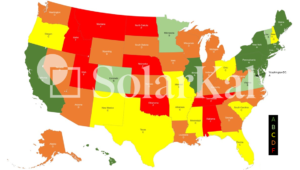The 50 States of Solar: An Inside Look at How SolarKal Grades Each State
Tracking solar policy is imperative to understanding if projects can work economically for commercial clients. SolarKal’s proprietary evaluation methodology covers all 50 states and allows us to “grade” each market, guiding us to where the best opportunities lie. The four key criteria for grading a state are incentives, electricity rates, net metering rules, and solar irradiation. Let’s look at what goes into SolarKal’s state grades.
Incentives include things like state rebates, SRECs (solar renewable energy certificates), and other solar programs such as community solar. For example, in New York, we monitor the ever-evolving upfront rebates, while in California, a possible community solar program could open up solar for large industrial buildings across the state.
Knowing energy rates is vital to helping a solar project make economic sense since lowering a building’s electric bill is often the main way to repay the solar investment. States like Pennsylvania, where solar has historically had longer payback periods, have seen commercial energy rate hikes recently, making for shorter payback periods.
Next, we track net metering rules that vary by state and utility. Net metering rules determine how much a utility will pay for solar power sent to the grid. States like California have moved from traditional net metering to net billing, which greatly impacts the economics of solar installations.
Lastly, each state is graded on solar irradiation or the amount of sun it receives. The more sun, the better! But just because a site gets a lot of sun doesn’t mean it’s good for solar. Florida, for instance, may be the Sunshine State with great solar irradiance but lacks the incentives to get commercial projects to pencil.
Finally, just because a client has a building in a “tough” solar state doesn’t mean it’s not doable. It’s important to note that this is only a starting point for analysis, and that SolarKal weighs each criteria differently based on the clients’ requirements. In some places, utility specific programs can vary widely within states. Certain parts of a market may be eligible for extra federal incentives. Later in our process, each property is closely evaluated to determine whether it’s a solid opportunity, or not. We put together detailed site-specific economics regardless of the state grade.
And, of course, many companies implement solar for reasons unrelated to economics to lower their CO2 emissions and meet sustainability goals.
Each state has a unique solar market. Keeping track of the evolving policies is our job and telling you which properties to focus your time on is part of our expertise. Having a diverse real estate portfolio spanning the 50 states can be overwhelming, but SolarKal is here to make going solar easy and accessible.


